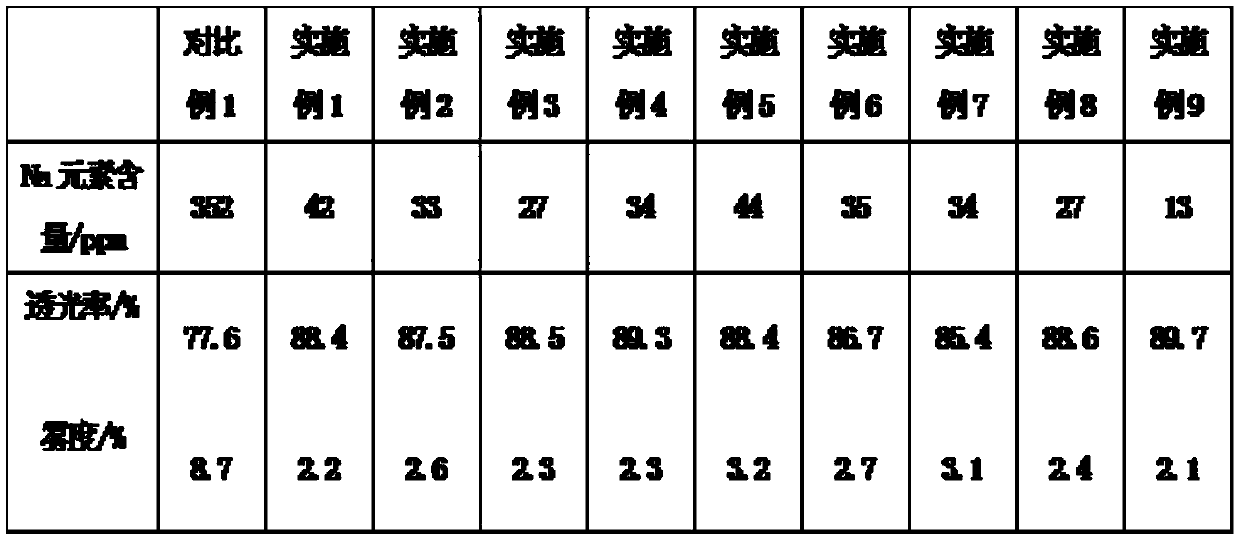Sulfone polymer composition and preparation method thereof
A technology of polymer and composition, applied in the field of sulfone polymer composition and preparation thereof, high temperature resistant transparent thermoplastic engineering plastic sulfone polymer and composition thereof
- Summary
- Abstract
- Description
- Claims
- Application Information
AI Technical Summary
Problems solved by technology
Method used
Image
Examples
Embodiment 1
[0042] In the three-necked flask equipped with a thermometer, a nitrogen pipe, a condensing water separator, and a stirrer, 125.15g (0.5mol) of 4,4'-dihydroxydiphenylsulfone and 147.17g (0.5125mol) of ) 4,4'-dichlorodiphenyl sulfone, then add 426g sulfolane solvent, stir and heat up to 80°C to dissolve the monomer until the solution is transparent, add 55.65g sodium carbonate, then add 80mL xylene, continue stirring and heat up to 140°C Under certain conditions, the salt-forming reaction begins, and the azeotrope formed by the water and xylene produced in the system is blown out into the condenser by the protective gas, and the condensation drops to the water separator for stratification, and the xylene in the upper layer flows back into the system Keep the temperature in the range of 200°C-210°C, when the collected water yield is close to the theoretical value (9g), continue to reflux for 20 minutes, and no water drops are observed, which proves that the salt formation is comp...
Embodiment 2
[0047] The method is basically the same as in Example 1, except that the monomer 4,4'-dihydroxydiphenylsulfone (bisphenol S) is replaced by 125.13g (0.5mol) of 4,4'-dihydroxybiphenyl, and then 426g Sulfolane solvent, after heating up and dissolving, add 80mL of water-carrying agent xylene, 55.65g of salt-forming agent sodium carbonate, control the temperature of water-carrying at 180°C until no water is formed, continue to heat up to 190°C, keep warm for 1 hour, and separate by heating Xylene is produced, and the polymerization temperature is in the range of 210°C-230°C to obtain the polyphenylsulfone polymer PPSU material. The performance characterization comparison data is shown in the table below.
Embodiment 3
[0049] The method is basically the same as in Example 1, except that 4,4'-dihydroxydiphenylsulfone (bisphenol S) is replaced by 114.14g (0.5mol) of 2,2-bis(4-hydroxyphenyl)propane, and then Add 426g of sulfolane solvent, heat up and dissolve, add water-carrying agent xylene 80mL, salt-forming agent sodium carbonate 55.65g, and control the temperature of water-carrying at 180°C until anhydrous is formed, continue to heat up to 190°C, and keep warm for 1 hour. (Bisphenol A polymerization temperature ranges from 200°C to 220°C to obtain polysulfone polymer PSU material. Performance characterization comparison data are shown in Table 1 below.
PUM
 Login to View More
Login to View More Abstract
Description
Claims
Application Information
 Login to View More
Login to View More - R&D
- Intellectual Property
- Life Sciences
- Materials
- Tech Scout
- Unparalleled Data Quality
- Higher Quality Content
- 60% Fewer Hallucinations
Browse by: Latest US Patents, China's latest patents, Technical Efficacy Thesaurus, Application Domain, Technology Topic, Popular Technical Reports.
© 2025 PatSnap. All rights reserved.Legal|Privacy policy|Modern Slavery Act Transparency Statement|Sitemap|About US| Contact US: help@patsnap.com


